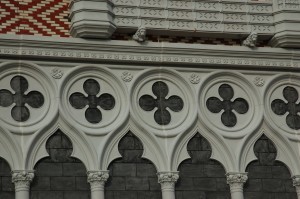Terra Cotta Tracery
One of the many features on buildings that have terra cotta architectural elements is intricate and beautiful tracery. Over time, however, this striking building element can deteriorate and need replacement. Yet, this is not always easy, especially if the detail is complex and much of the pattern has been lost. Without having to struggle with recreating the terra cotta color and texture for the tracery, there is now a solution to help restore terra cotta tracery thanks to an innovative material called TerraGlas®.
Terra Cotta Tracery
Tracery is an ornamental architectural feature that consists of bars or what is known as ramified ribs. This type of architectural feature is typically found on screens, panels, and the top portion of Gothic windows. The tracery is often very delicate and complex in its detail and design.
The Effects of Deterioration on a Terra Cotta Tracery
Over time, terra cotta begins to deteriorate. Since the material is typically on the outside of a building, it is exposed to wind, rain, chemicals and other harsh elements that can start to wear down the material. The terra cotta can often begin to crumble once water has regularly come into contact with it or it can simply just deteriorate into fine dust from the wind and exposure.
While terra cotta tracery may not necessarily be a large feature or heavy, it can fall off and cause some risk for injury. Also, losing the design and pattern detail on a building can take away from its beauty and grandeur.
Restoring Tracery with TerraGlas
When restoration projects on older buildings often require fixing very detailed or complex designs, the challenge is often about matching the design or understanding what it is supposed to look like. There may not be enough of the tracery left to recreate it or contractors or restoration experts may need to rely on old photographs. The other issue is that matching the terra cotta color and texture after such a long time period can be difficult.
However, TerraGlas answers all these challenges and offers significant benefits for these types of restoration projects. First, the professional technicians behind TerraGlas can use technology to create a perfect match to what is left of the existing terra cotta tracery, including identifying the color, texture, and pattern so there will be no uneven look to the finished product. Second, TerraGlas is a lighter weight product that makes it easy to work with and install on a building. The building will experience a lower load overall on the structure, which allows the terra cotta features to last longer.
Despite being a lightweight alternative to traditional terra cotta, it holds up longer due to its strength and durability. In fact, lab tests show that TerraGlas can withstand quite a bit more than traditional terra cotta, including water, fire, earthquakes, wind, temperature changes and other elements. This makes it a great choice in terms of the value that the restoration material can offer over time.
More Information on TerraGlas for Tracery
If you are looking to restore terra cotta tracery or other architectural elements on your structure, consider partnering with the team at TerraGlas® who has the experience and expertise to deliver all your restoration needs. You can reach us for more information or a free estimate at 903.454.0904 or through email at: [email protected].



May 5, 2014
Terra Cotta Restoration, Tips and Hints